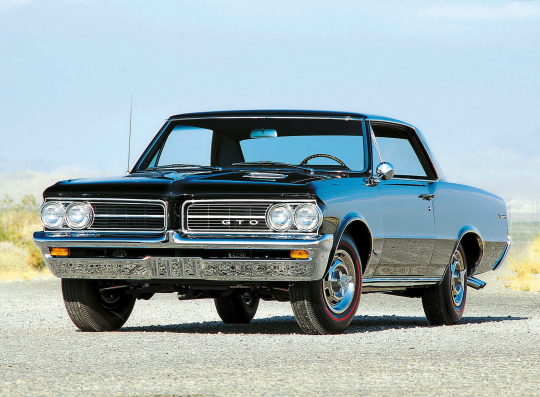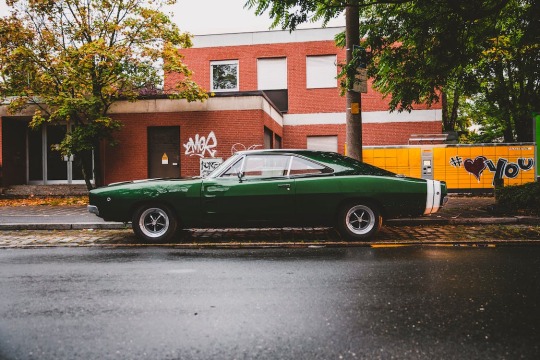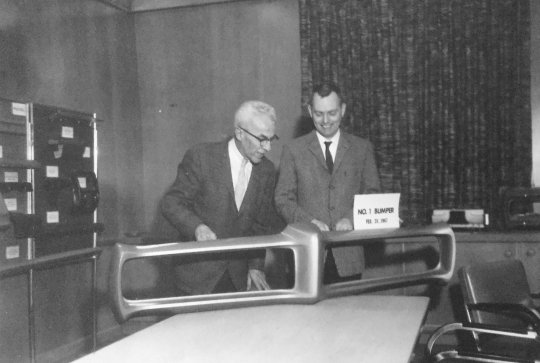#1964 pontiac gto
Explore tagged Tumblr posts
Text

From the car files: a 1964 Pontiac GTO.
#pontiac#pontiac gto#the 60s#1964#gto#gm#general motors#classic cars#muscle cars#american muscle#1964 pontiac#1964 pontiac gto#1964 gto
122 notes
·
View notes
Photo

(via Legendary Pontiac ‘Grey Ghost’ Trans Am Racer Could Be Yours For Just $675,000)
7 notes
·
View notes
Text
Buyer's Guide to the 1964 Pontiac GTO @Hemmings
The Pontiac Synonymous with ’60s Performance is Still a Perennial Favourite For some Baby Boomers, Pontiac’s GTO is the automotive equivalent of Jimi Hendrix’s Star Spangled Banner guitar shred at Woodstock: powerful, iconic and emblematic of an extraordinary era in American history. Pontiac offered a GTO until 1974, then dusted off the badge again for its last hoorah 30 years later on the 2004-…

View On WordPress
1 note
·
View note
Text

1964 Pontiac GTO Convertible
318 notes
·
View notes
Text

The 2+2 was a special high-performance package offered for the big body, but shorter wheelbase Catalina that was first offered in 1964 for $291.00. Consider this the “big brother” of the GTO. The package consists of bucket seats, a floor mounted shifter, special blend carpeting, and if you checked a few additional boxes, a 421 tri-power V8 backed by a 4-speed manual or 3-speed Hydramatic transmission. A long list of performance options could turn a comfy cruiser into a hot one!
The 2+2 package would continue for several more years in both hardtop and convertible bodies. Today, these cars are among the most sought-after Big Body Muscle Machines ever produced. Production would be a mere 7,998 in its inaugural year, 11,521 in ’65, 6,383 for ’66 and just 1,768 in ’67. Think about it...when was the last time you saw a Pontiac 2+2 up close and in person? This year you find an entire row of them at the MCACN show.
Special Thanks go out to Jack Anderson who coordinated this awesome display, and for bringing this 2 + 2, and to all the owners who are allowing us to host a stellar group of rare Big Body Muscle.
#mcacn#mcacn2024#pontiac#pontiac2+2#mcacnbigbodymuscle#pontiac2+2registry#mcacnshow#mcacn_show#musclecars#musclecar
33 notes
·
View notes
Text

Pontiac Tempest LeMans GTO 1964. - source Amazing Classic Cars.
73 notes
·
View notes
Text
Michael Savage’s Picks: Muscle Cars from America’s Golden Age
The golden age of muscle cars was a thrilling chapter in American automotive history. From the mid-1960s to the early 1970s, muscle cars dominated the streets with their roaring engines, bold designs, and raw power. These high-performance cars represented freedom, speed, and rebellion, capturing the spirit of an era where bigger and faster was always better. Here’s a look at some of the muscle cars that left an indelible mark on American culture.

1. 1967 Ford Mustang GT
The Ford Mustang was the car that started the muscle car craze. While it debuted in 1964, the 1967 GT model became a symbol of American automotive power. With its sleek lines and optional 390-cubic-inch V8 engine, the Mustang GT could pack a punch both on the road and at the drag strip. The Mustang also became a cultural icon, appearing in movies, TV shows, and music, cementing its legacy in American pop culture.
2. 1969 Dodge Charger R/T
The 1969 Dodge Charger R/T is one of the most recognizable muscle cars ever made. Known for its aggressive stance and the optional 426 Hemi engine, the Charger was all about performance. Its appearance in popular media, most notably in "The Dukes of Hazzard" and the "Fast and Furious" franchise, helped cement its place in muscle car history. The Charger’s bold design and unrelenting power made it a favorite among muscle car enthusiasts.
3. 1970 Chevrolet Chevelle SS
When it comes to raw muscle, few cars can rival the 1970 Chevrolet Chevelle SS. This beast came with a 454-cubic-inch V8 engine, producing up to 450 horsepower. The Chevelle SS embodied everything that made the muscle car era special: power, performance, and style. Its signature twin racing stripes and aggressive front-end design made it an instant classic and a favorite among collectors.
4. 1969 Pontiac GTO Judge
The Pontiac GTO, often referred to as "The Judge," was one of the cars that defined the muscle car era. With its high-performance engine options and eye-catching design, the GTO became synonymous with speed and power. The 1969 model, in particular, stood out with its Ram Air III and Ram Air IV engine options, making it a fierce competitor on the streets and the track.
5. 1970 Plymouth Barracuda
The Plymouth Barracuda, especially the 1970 model, was another iconic muscle car of the golden era. With its aggressive styling and powerful Hemi V8 engine, the ‘Cuda was a force to be reckoned with. It combined a sporty design with the ability to produce over 425 horsepower, making it a favorite among muscle car purists. The Barracuda’s distinct look and incredible performance made it a legend.
Why These Muscle Cars Still Matter
Muscle cars from the golden age of American power were not just vehicles; they were statements. They represented a time when automotive design was focused on creating powerful, fast, and stylish machines. Even today, muscle cars from the 1960s and 1970s are celebrated by car enthusiasts, collectors, and pop culture alike. Whether it's the rumble of a V8 engine or the sleek lines of a classic design, these cars continue to inspire admiration and awe.
About Michael Savage from New Canaan
Michael Savage, a muscle car enthusiast from New Canaan, has been fascinated by American automotive history since he was young. His passion for collecting and restoring classic muscle cars, especially from the golden age, has driven him to become a well-known figure in the muscle car community. As a successful businessman, health advisor, and proud family man, Michael Savage enjoys balancing his professional life with his love for fast, powerful machines.
#musclecar#american muscle#automotive#vehicle#ford mustang gt#dodge charger#chevrolet chevelle#Pontiac GTO Judge#plymouth barracuda#classic car#chevelle#Michael Savage#Michael Savage New Canaan#Mike Savage New Canaan
2 notes
·
View notes
Photo

New Post has been published on https://fastmusclecar.com/exploring-the-timeless-appeal-of-classic-vintage-muscle-cars/best-muscle-cars/
Exploring the Timeless Appeal of Classic Vintage Muscle Cars
In the fast-paced world of automobiles, where each passing year brings forth innovations and modern designs, a class of vehicles seems to defy the sands of time. With their roaring engines and iconic designs, classic vintage muscle cars maintain an enduring appeal that transcends generations. This article explores the reasons behind the timeless allure of these automotive legends.
The Birth of an Icon
Classic muscle cars arose in the mid-twentieth century, fueled by post-World War II optimism and a thirst for speed. Sensing a demand for excitement on the road, American automakers developed muscle cars. The Ford Mustang, Chevrolet Camaro, and Dodge Charger emerged as trailblazers, representing the spirit of defiance and power that defined a period. These brands are characterized by unique engine and body parts that ultimately make the automobile stand out. You can see more info here about various automotive products from these brands.
The allure of classic muscle cars lies in their performance and their symbolism. These vehicles were born when the open road symbolized freedom and driving was not just a means of transportation but an expression of individualism and adventure.
Some of the most iconic classic muscle cars that have left an indelible mark on the industry are:
Ford Mustang
Model Years: 1964-1973
The Ford Mustang is an American icon and one of the pioneers of the muscle car era. Its introduction in 1964 created the “pony car” class, offering a blend of style, performance and affordability. The 1967 Shelby GT500 is particularly revered, featuring a powerful 428 Cobra Jet engine.
Dodge Charger
Model Years: 1966-1974
The Dodge Charger is known for its bold design and powerful engines. The second-generation Charger (1968-1970) is often considered the pinnacle, with the iconic “Bullitt” Charger R/T and the monstrous Charger Daytona, designed for NASCAR dominance. The 1969 Charger, immortalized in movies like “The Dukes of Hazzard,” is particularly iconic.
Chevrolet Camaro
Model Years: 1967-1969
The Chevrolet Camaro is another heavyweight in the muscle car arena. The first-generation Camaro, especially the SS and Z/28 models, is celebrated for its aggressive styling and high-performance options. The 1969 Camaro ZL1 is one of the most sought-after muscle cars, boasting an all-aluminum 427 cubic-inch engine.
Pontiac GTO
Model Years: 1964-1974
Often credited as the first true muscle car, the Pontiac GTO paved the way for the revolution. The early GTOs, especially the 1966 model with the potent Tri-Power carburetion system, are highly coveted. The GTO embodied putting a big engine in a midsize car, creating a formula that defined the muscle car ethos.
Model Years: 1964-1972
Chevrolet Chevelle SS:
The Chevelle SS is a classic example of Chevrolet’s prowess in crafting muscle cars. The SS (Super Sport) package, available on various Chevelle models, turned these midsize cars into high-performance beasts. The 1970 Chevelle SS with the LS6 454 cubic-inch V8 is legendary, boasting one of the highest factory horsepower ratings of the era.
Design Elegance that Stands the Test of Time
The timeless design of classic muscle vehicles is one of their distinguishing features. The sleek forms, forceful poses and eye-catching color palettes distinguish them from their counterparts. The union of form and function in these vehicles reflects a time when style was just as vital as substance. Even in the middle of a sea of modern automobiles, the timeless beauty of their design guarantees that these cars remain head-turners.
Classic muscle cars are not just machines but works of art on wheels. The aesthetic appeal of their design is not subject to the whims of passing trends, making them a testament to the notion that true beauty is eternal.
Nostalgia and Cultural Significance
Beyond their mechanical prowess, classic muscle cars carry a cultural significance that adds layers to their timeless appeal. These vehicles are not just relics of the past; they are living reminders of a bygone era. Nostalgia plays a pivotal role in their enduring popularity, as they evoke memories of when the automobile represented more than just a mode of transportation.
Movies, music and popular culture have all contributed to the mystique surrounding classic muscle cars. From iconic scenes in films to the rock ‘n’ roll tunes that echoed through the radio waves, these cars became intertwined with the cultural fabric of their time. Owning a classic muscle car is not just about having a vehicle; it’s about possessing a piece of history that encapsulates the spirit of an era.
Conclusion
In a world where trends come and go and technology advances relentlessly, classic vintage muscle cars stand as stalwart guardians of a bygone era. The birth of these iconic vehicles marked a turning point in automotive history, and their timeless allure continues to captivate enthusiasts across the globe. From the engine’s roar to the elegance of their design, classic muscle cars are more than just vehicles; they are living legends, embodying the spirit of an age that refuses to be forgotten.
7 notes
·
View notes
Text

1968 GTO
Pontiac History - The first Endura bumper for the 1968 GTO is shown here on February 28th, 1967, at Inland Manufacturing, a division of General Motors. The story of how this material was developed is fascinating. It was first used back in 1964 on 'push' vehicles that pushed non-running cars around the Pontiac engineering garage. Inland continually improved the material. The first use of Endura on a production vehicle were Pontiac emblems that appeared on the noses of 1967 Firebird 400s and B-Body Pontiacs. The next phase was to develop an entire front bumper of high density microcellular polymer foam and coat it with urethane paint to match the factory applied body paint of a 1968 GTO. The original name for this material was Indura (all Inland Manufacturing products started with "IN") but Pontiac didn't want a marketing name to refer to another division, so they changed the name to Endura. Thanks to Paul Haines for his insight into the Endura story. - MCN
37 notes
·
View notes
Video
tumblr
32182 BOGE AUTOMATIC AMORTIGUADOR Buick LeSabre, Buick Regal, Buick Riviera, Buick Roadmaster, Buic32182 BOGE - ¡TECNOLOGÍA ALEMANA PARA LOS CAMINOS DE MÉXICO! Diariamente en las difíciles calles de México, los vehículos se enfrentan a numerosos retos que son una amenaza en la seguridad al conducir: Baches, hoyos, exceso de carga y numerosos pasajeros en el mismo vehículo. Estos factores producen graves daños en los amortiguadores y en otras partes de la suspensión, por tal motivo, los amortiguadores BOGE están diseñados con la más alta tecnología y calidad de Equipo Original para conseguir el máximo control al conducir un vehículo. BOGE AUTOMATIC - La línea de amortiguadores hidráulicos diseñados con calidad superior a la del equipo original, ofrece un óptimo desempeño con máxima seguridad en la conducción del automóvil. Buick LeSabre: 1971 1972 1973 1974 1975 1976 1977 1978 1979 1980 1981 1982 1983 1984 1985, Buick Regal: 1982 1983 1984 1985 1986 1987, Buick Riviera: 1971 1972 1973 1974 1975 1976 1977 1978, Buick Roadmaster: 1991 1992 1993 1994, Buick Skylark: 1968 1969 1970 1971 1972, Buick Special: 1968 1969, Cadillac DeVille: 1977 1978 1979 1980 1981 1982 1983 1984, Chevrolet Caprice: 1976 1977 1978 1979 1980 1981 1982, Chevrolet Chevelle: 1968 1969 1970 1971 1972 1973, Chevrolet El Camino: 1964 1965 1966 1967 1968 1969 1970 1971 1972 1973 1974 1975 1976 1977 1978 1979 1980 1981 1982 1983 1984 1985 1986 1987, Chevrolet Impala: 1967 1968 1969 1970 1971 1972 1973 1974 1975, Chevrolet Malibu: 1979 1980 1981 1982 1983, Chevrolet Monte Carlo: 1970 1971 1972 1973 1974 1975 1976 1977 1978 1979 1980 1981 1982 1983 1984 1985 1986 1987 1988, Chevrolet Sprint: 1985 1986 1987, GMC Caballero: 1978 1979 1980 1981 1982 1983 1984 1985 1986 1987, Oldsmobile Cutlass: 1973 1974 1975 1976 1977 1978 1979 1980 1981 1985 1986 1987 1988, Oldsmobile Cutlass Supreme: 1973 1974 1975 1976 1977 1978 1979 1980 1981 1982 1983 1984 1985 1986 1987 1988, Oldsmobile Delta 88: 1965 1966 1967 1968 1969 1970 1971 1972 1973 1974 1975 1976 1977 1978 1979 1980 1981 1982 1983 1984 1985, Oldsmobile Vista Cruiser: 1964 1965 1966 1967 1968 1969 1970 1971 1972, Pontiac Bonneville: 1971 1972 1973 1974 1975 1976 1977 1978 1979 1980 1981 1982 1983 1984 1985 1986 1988 1989, Pontiac Grand Am: 1989, Pontiac Grand Prix: 1965 1966 1967 1968 1969 1970 1971 1972 1973 1974 1975 1976 1977 1978 1979 1980 1981 1982 1983 1984 1985 1986 1987 1988, Pontiac GTO: 1964 1965 1966 1967 1968 1969 1970 1971 1972 1973, Pontiac LeMans: 1964 1965 1966 1967 1968 1969 1970 1971 1972 1973 1974 1975 1976 1977 1978 1979 1980 1981, Pontiac Tempest: 1964 1965 1966 1967 1968 1969 1970 Buick LeSabre: 1971 - 1985, Buick Regal: 1982 - 1987, Buick Riviera: 1971 - 1978, Buick Roadmaster: 1991 - 1994, Buick Skylark: 1968 - 1972, Buick Special: 1968 - 1969, Cadillac DeVille: 1977 - 1984, Chevrolet Caprice: 1976 - 1982, Chevrolet Chevelle: 1968 - 1973, Chevrolet El Camino: 1964 - 1987, Chevrolet Impala: 1967 - 1975, Chevrolet Malibu: 1979 - 1983, Chevrolet Monte Carlo: 1970 - 1988, Chevrolet Sprint: 1985 - 1987, GMC Caballero: 1978 - 1987, Oldsmobile Cutlass: 1973 - 1988, Oldsmobile Cutlass Supreme: 1973 - 1988, Oldsmobile Delta 88: 1965 - 1985, Oldsmobile Vista Cruiser: 1964 - 1972, Pontiac Bonneville: 1971 - 1989, Pontiac Grand Am: 1989 - 1989, Pontiac Grand Prix: 1965 - 1988, Pontiac GTO: 1964 - 1973, Pontiac LeMans: 1964 - 1981, Pontiac Tempest: 1964 - 1970 Buick LeSabre, Buick Regal, Buick Riviera, Buick Roadmaster, Buick Skylark, Buick Special, Cadillac DeVille, Chevrolet Caprice, Chevrolet Chevelle, Chevrolet El Camino, Chevrolet Impala, Chevrolet Malibu, Chevrolet Monte Carlo, Chevrolet Sprint, GMC Caballero, Oldsmobile Cutlass, Oldsmobile Cutlass Supreme, Oldsmobile Delta 88, Oldsmobile Vista Cruiser, Pontiac Bonneville, Pontiac Grand Am, Pontiac Grand Prix, Pontiac GTO, Pontiac LeMans, Pontiac Tempest https://zf.tecalliance-solutions.com.mx/articles/detail/32182 Mirar 32182 BOGE AUTOMATIC AMORTIGUADOR Buick LeSabre, Buick Regal, Buick Riviera, Buick Roadmaster, Buic
2 notes
·
View notes







